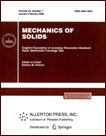 | | Mechanics of Solids
A Journal of Russian Academy of Sciences | | Founded
in January 1966
Issued 6 times a year
Print ISSN 0025-6544
Online ISSN 1934-7936 |
Archive of Issues
| Total articles in the database: | | 13362 |
| In Russian (Èçâ. ÐÀÍ. ÌÒÒ): | | 8178
|
| In English (Mech. Solids): | | 5184 |
|
| << Previous article | Volume 59, Issue 8 / 2024 | Next article >> |
| Kazim Ercan, Mehmet Akif Dundar, and Hamza Kemal Akyildiz, "Investigating the Flexural Behavior of Ultra-High-Molecular-Weight Polyethylene at a Low Bending Rate: Experimental and Numerical Study," Mech. Solids. 59 (8), 3968-3984 (2024) |
| Year |
2024 |
Volume |
59 |
Number |
8 |
Pages |
3968-3984 |
| DOI |
10.1134/S0025654424605032 |
| Title |
Investigating the Flexural Behavior of Ultra-High-Molecular-Weight Polyethylene at a Low Bending Rate: Experimental and Numerical Study |
| Author(s) |
Kazim Ercan (Yozgat Bozok University, College of Engineering, Mechanical Engineering Department, Yozgat, 66100 Turkey, kazim.ercan@yobu.edu.tr)
Mehmet Akif Dundar (Yozgat Bozok University, College of Engineering, Mechanical Engineering Department, Yozgat, 66100 Turkey, m.akif.dundar@yobu.edu.tr)
Hamza Kemal Akyildiz (Yozgat Bozok University, College of Engineering, Mechanical Engineering Department, Yozgat, 66100 Turkey, hkemal.akyildiz@bozok.edu.tr) |
| Abstract |
This study examines the mechanical behavior of ultra-high-molecular-weight polyethylene (UHMWPE) under three-point bending at a low strain rate, with a particular focus on evaluating the influence of its distinct tensile and compressive properties on its bending response through finite element analysis. The tensile and compressive stress-strain characteristics of UHMWPE were experimentally determined at a strain rate of 5×10−3 s−1, complemented by three-point bending tests conducted at a constant loading speed of 0.05 mm/s. To predict the flexural behavior of UHMWPE, two finite element models were constructed using the SAMP-1 material model in LS-DYNA: one incorporating the Von-Mises yield surface, which assumes similar material behavior in tension and compression, and the other employing the Drucker-Prager yield surface, which accounts for dissimilar material behaviors between tension and compression. Results of the numerical analyses revealed substantial discrepancies between the predictions of the Von-Mises and Drucker-Prager models, with the latter offering a more precise prediction of the flexural response of UHMWPE, thereby underscoring the critical importance of accounting for dissimilar material behaviors to achieve enhanced predictive accuracy. |
| Keywords |
Ultra-high molecular weight polyethylene (UHMWPE), three-point bending, finite element modeling, dissimilar material behavior, SAMP-1 |
| Received |
12 August 2024 | Revised |
03 December 2024 | Accepted |
03 December 2024 |
| Link to Fulltext |
|
| << Previous article | Volume 59, Issue 8 / 2024 | Next article >> |
|
 If you find a misprint on a webpage, please help us correct it promptly - just highlight and press Ctrl+Enter If you find a misprint on a webpage, please help us correct it promptly - just highlight and press Ctrl+Enter
|
|

 Russian
Russian  English
English